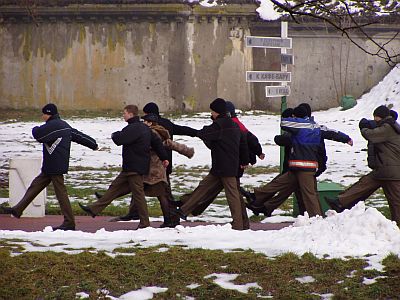History - a short overview
Today, Belarus is a souvereign and fully independent country, which is not for the first time in its history, but historically spoken rather an exception. The country has always marked the crossing point of various historically important cultures such as Russia, →Lithuania, →Poland and during the 20th century, exclusively in a negative meaning, Germany.
A closer look at the Archeological Museum of →Brest unveils, that there was not very much going on until the year 1000 A.D. Many small settlements consisting of small wooden houses dominated the countryside (well, and still do so today in some areas). After the year 1000, first small and souvereign principalities developed. After the 13th century, large parts of present-day Belarus became a part of the →Grand Duchy of Lithuania, initiating its first period of prosperity. Belarusian even became the official language of the duchy. The situation was not about to change substantially within the next centuries. However, the Russian influence grew stronger after the year 1800. Finally the region was taken over by the Russian empire. Until 1905, the Belarusian language was forbidden by the Russian rulers.
The 1st World War didn't spare the Belarus. In 1918, Belarusians tried to make use of the post-revolutionary confusion and proclaimed the White Russian People's Republic. Soon the new republic was doomed. A few months later, the Bolsheviki invaded the country. Poland asserted its claim to the area, too, and so the Belarus was divided - the western part of the country up to a line between the capital →Minsk and →Nyazvizh (aka: Nesvish) belonged to the →Republic of Poland, the eastern part was declared Belarusian Socialist Soviet Republic. The Soviet part was granted certain autonomous rights, with Belarusian, Polish and Russian as the offcial languages. But during the years before the 2nd World War, Stalin's reign of terror hit the Belarus. Countless Belarusians were deported or murdered within a few years.
According to the secret protocol of the Treaty of Nonaggression between Germany and the USSR, Poland was about to be divided between the two countries. And so the Red Army and the Wehrmacht were facing each other near →Brest since 1939 along the present-day Belarusian-Polish borderline. In 1941, the Nazi blitzkrieg against the Soviet Union hit the Belarus first. Within a couple of weeks, the entire country was invaded. The intruders destroyed virtually everything - all towns and almost 10,000 villages were levelled. The German tactic of scorched earth was most consequently applied to the Belarus. Hence, it doesn't come as a surprise that there are not many buildings left from the time before the war started. It was not before 1944 that the Red Army recaptured the Belarus.

| ||
| Belarus: Marching lock-step |
As in almost all countries invaded by Nazi Germany, the highest toll was taken from the Jewish population. Hundred thousands of Jews started settling in the Belarus since the late medieval age. In many towns such as Minsk, Hrodna or Brest they had a share of almost 50%. As in many other Eastern European countries, the Jews occasionally suffered more or less severe pogroms, but things became much worse during the German occupation from 1941 to 1944. The majority of the Jewish community was wiped out. But there were also large Jewish partisan groups hiding in the forests and fighting against the German invaders.
As a result of several conferences dealing with the post-war order of central Europe, Poland was simply moved a few hundred kilometres to the west - to the disadvantage of Germany and to the advantage of the Soviet Union and the Belarus respectively. Belarus' area almost doubled. After the war, the reconstruction of the country following Stalin's principles as well as a massive industrialisation started. Together with the industrial progress, the process of Russification was enforced. Due to the russification, the Belarus culture was headed for obscurity within the next decades.
In 1991, Belarus followed the general trend and declared its independence again. The Communist Party was forbidden, and the government started to privatise formerly state-owned enterprises. This and other reforms caused a breathtaking inflation and the general plummeting of the standard of living. But despite all the side effects, a positive trend was in evidence. However, the communists gained strength again. In the year 1993, the government acknowledged the Communist Party again. As a result of the direct presidential election in 1997, Alexander Lukashenko became the president of the Belarus. Ever since, he is turning back the clock and sticking to the power by expanding his authority. Among other measures, Lukashenko enabled the change of the Belarus constitution so that he can be re-elected. Belarus now shuts itself away from the West in favour of a strong partnership with its eastern neighbour Russia. But there are also recent problems between Russia and the Belarus. According to various sources, basic rights are more and more restricted. To give an example, Belarus planned to abolish the freedom of travel for underage persons in the end of the year 2004. Another example is the fact that Belarus' print media and tv etc are forced into line. A great example for this is the weekly English journal Minsk Times. Sometimes visitors will feel like traveling back in time, visiting the Soviet Union before 1989. With all of its negative consequences.
One can only hope that the Belarus does not develop into a European North Korea. As a frequent traveler of Eastern European countries I can only conclude the following: No country in Europe is further away from a united Europe than the Belarus. I even got the impression that countries like →Transdniestr can learn something from Lukashenko. Anyway, the people are usually very nice and it's a rewarding destination for travelers looking for the chance to get a glimpse again of the Ol' Soviet Union.
©2024 Europe-East.com

 Albania
Albania Belarus
Belarus